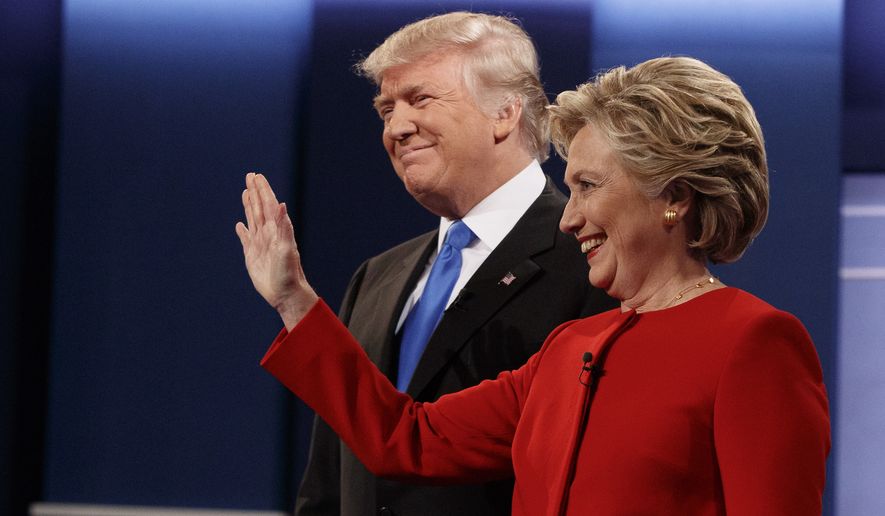OPINION:
As we careen into the 2020 campaign season, and prepare to endure an endless deluge of chit chat about the presidential election, it might be useful to think about how President Trump won in 2016. Not why he won, but the actual mechanics of the victory. After all, if you don’t know how you won or lost, it might be difficult to figure out how best to replicate (or avoid replicating) the outcome.
The prevailing narrative about the 2016 election is that the president defeated former Secretary of State Hillary Clinton by mobilizing an essentially new army of white, working-class voters who had become disenchanted with the coastal elites and their indifference toward the concerns of “real” Americans. That is a distinct possibility, but it is not at all clear that the data bears that interpretation.
When you look at the numbers, a somewhat different picture emerges — one characterized by a few features not routinely mentioned.
First, Mrs. Clinton was not very popular. Her unfavorable ratings in the dozen or so surveys conducted immediately prior to Election Day averaged about 54 percent, while her favorable ratings in those surveys averaged about 42 percent, so she was about a dozen points underwater on Election Day. For comparison purposes, immediately before game day in 2012, fellow Democrat President Obama’s favorability ratings averaged about 8 points higher than his unfavorable ratings.
Second, in addition to, or perhaps because of that popularity problem, Mrs. Clinton was unable to turn out voters. A shade fewer than 137 million votes were cast in the presidential election in 2016, compared to a little bit more than 129 million in 2012. Despite that increase of almost 8 million votes, almost 62,000 fewer people voted for Mrs. Clinton in 2016 than voted for Mr. Obama in 2012.
Most of those extra 8 million votes did not go to Mr. Trump. He received only about 2 million more votes than Republican Sen. Mitt Romney of Utah had in 2012 (62.98 million vs. 60.93 million). The majority of those 8 million votes went to other candidates, especially Libertarian Party candidate Gary Johnson and the Green Party’s Jill Stein. In 2012, third parties received about 2.2 million vote. In 2016, that number surged to 7.8 million. When you think about the favorability ratings of the two main candidates in 2016, that makes perfect sense.
Third, Mr. Trump didn’t dazzle in the Midwest, but Mrs. Clinton did even worse. Much has been made of the president’s victory in Wisconsin, but he actually received fewer votes in Wisconsin than either Mr. Romney or Mr. Obama had in 2012. He picked up fewer votes than Mr. Obama did in Michigan, Pennsylvania and Iowa as well. Fortunately for him, Mrs. Clinton got even fewer votes in all those places. In Ohio, Mr. Trump won with just 13,384 more votes than Mr. Obama received in 2012. The Buckeye State was particularly bad for Mrs. Clinton: Mr. Romney got more votes there in 2012 (in excess of 250,000) than Mrs. Clinton did in 2016.
Finally, Mr. Trump did just a little bit better among some demographic groups — but not the ones you think — than Mr. Romney had in 2012. He won 8 percent of the African-American vote (compared to 6 percent for Mr. Romney). He won 28 percent of the Hispanic vote (compared to 27 percent for Mr. Romney). He won 27 percent of the Asian vote (compared to 26 percent for Mr. Romney).
What about white folks? Mr. Romney got 59 percent of white voters, Mr. Trump got 57 percent. How about older folks (those over 65)? Mr. Romney got 56 percent, Mr. Trump got 52 percent. That surge among the working class? Mr. Trump got 45 percent of those making less than $100,000 per year, Mr. Romney got 44 percent.
The president won in large measure because he was not Mrs. Clinton, because there were third-party candidates who scrambled the equation for just enough voters, and because he did better than Mr. Romney in a handful of demographic groups. He did not win because he was universally viewed as the salvation of the white working class or the unique bearer of the anger of the disenfranchised.
• Michael McKenna, a columnist for The Washington Times, is the president of MWR Strategies. He was most recently a deputy assistant to the president and deputy director of the Office of Legislative Affairs at the White House.




Please read our comment policy before commenting.